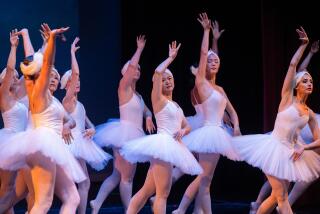Professional Ballerina
- Share via
The elegance, grace and pirouettes of a ballerina -- who doesn’t marvel at how well these artists perform? It certainly looks like a dream job to covet.
Electric images of dancers leaping and twirling don’t begin to expose the sweat and strain they undergo. A typical dancer goes through years of training, hours of rehearsal and harsh physical demands on their bodies. The strength and discipline required would make even the toughest athlete flinch.
While not recognized as athletes, that is exactly what ballet dancers are, where training starts at age nine with basic ballet technique.
If promise or strong desire is present (not to mention the ability to persevere in awkward toe shoes), than professional training school is the next step. Here, as many as six or seven classes per day may be required.
By the time the dancer becomes a ballerina, the rigors and discipline of ballet become her life. She will train and work hard to keep her body in top physical form.
No easy task considering that life in a dance troupe starts with morning classes (2 to 3 hours) then add four to six hours of rehearsal after lunch. This doesn’t include run-through rehearsals before performances. Of course the ritual starts again the next day -- clearly not for the faint at heart.
Albert Einstein once called ballet dancers “Athletes of God,” if that’s true, then these performers could use a pay increase. A principle dancer/soloist in an acclaimed company such as the American Ballet Theatre can earn on average $180,000 while a company dancer takes in $70,000.
More to Read
Inside the business of entertainment
The Wide Shot brings you news, analysis and insights on everything from streaming wars to production — and what it all means for the future.
You may occasionally receive promotional content from the Los Angeles Times.










